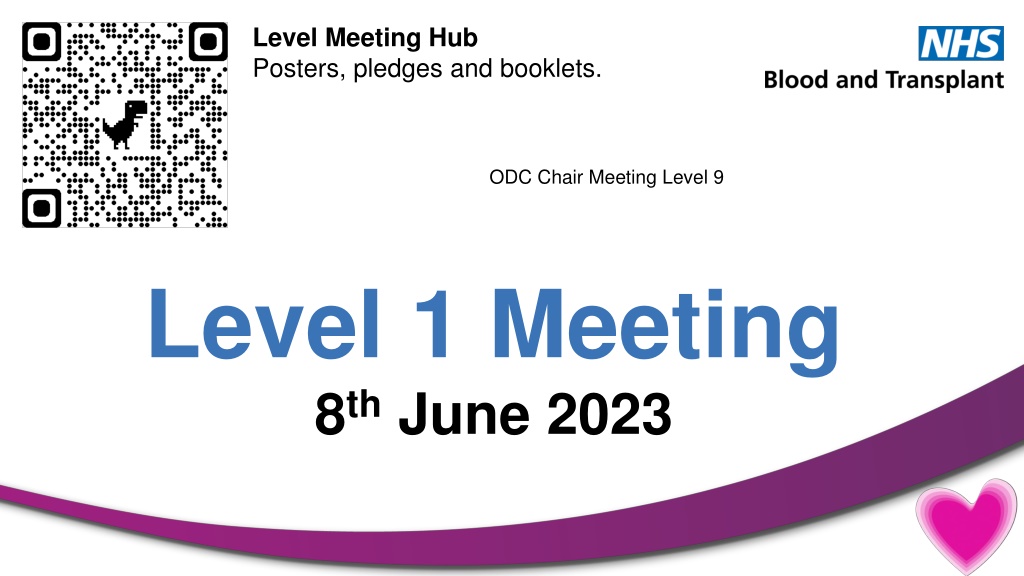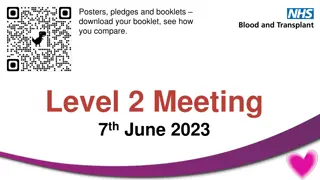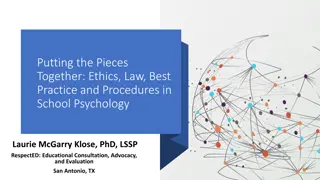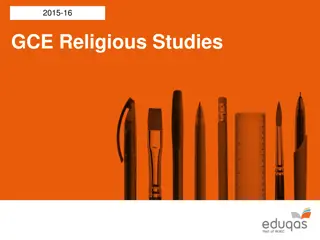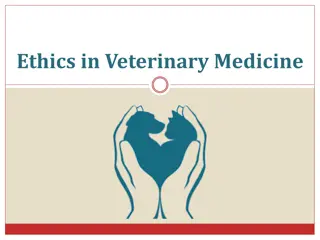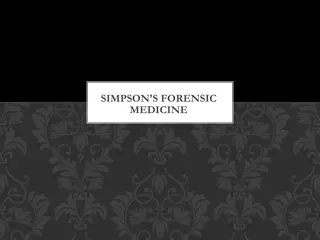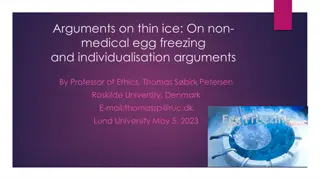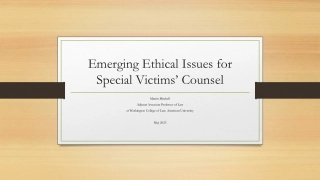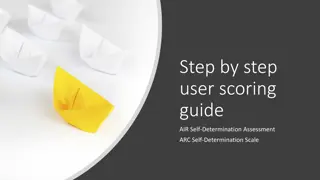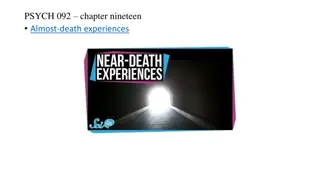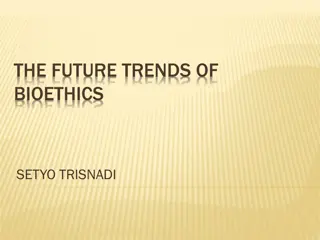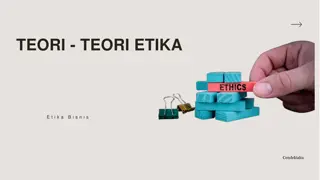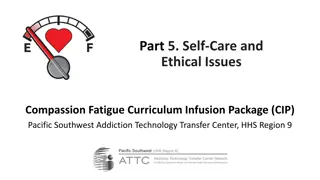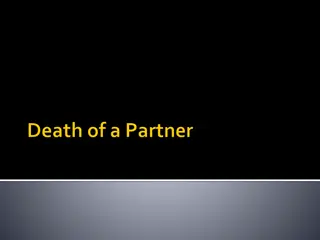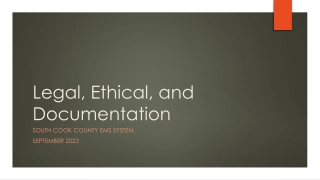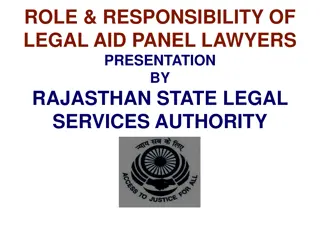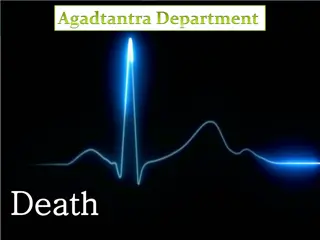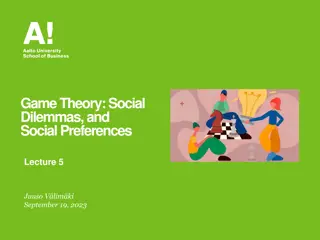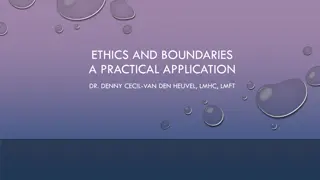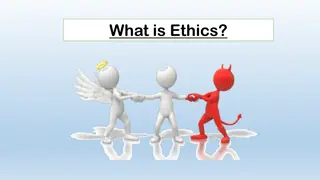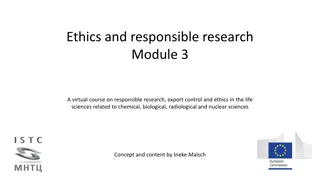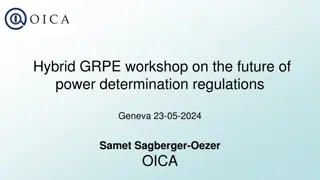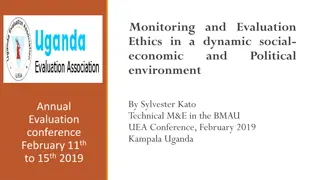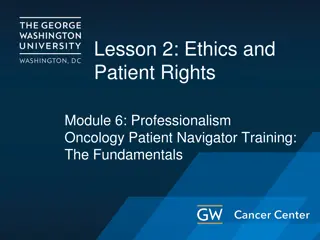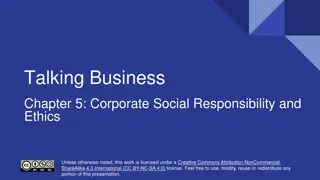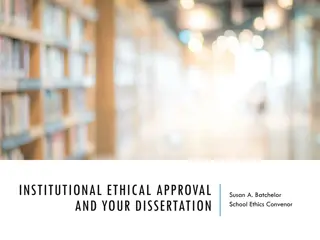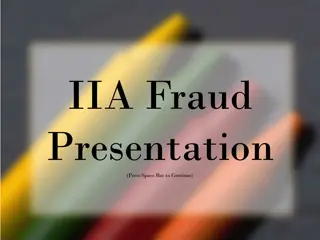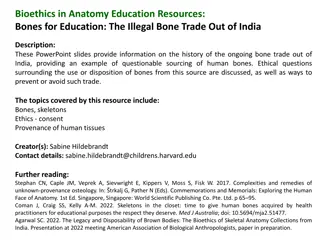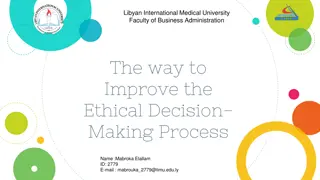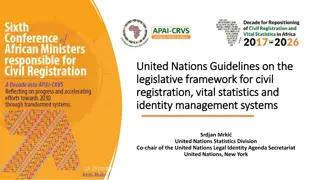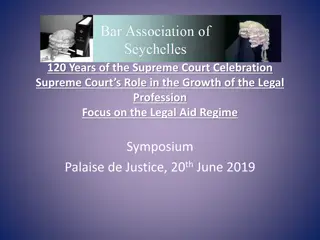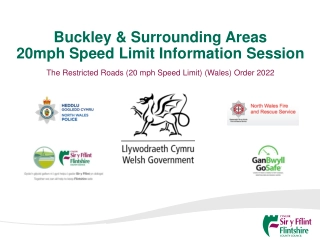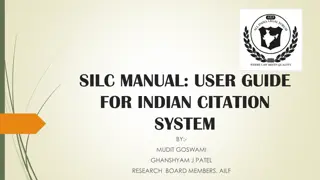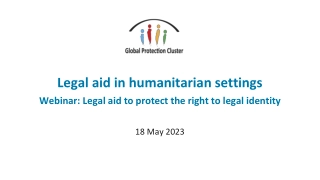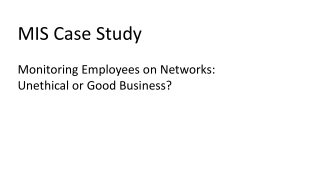Legal Challenges and Ethical Dilemmas Surrounding Death Determination Criteria
Legal challenges and ethical dilemmas persist worldwide regarding the determination of death using neurological criteria. Courts grapple with defining clear distinctions between life and death, especially when exceptions are requested for specific cases. Recent cases like the Archie Battersbee case shed light on the complexities of determining death and the role of medical testing, court decisions, and best interests considerations.
Download Presentation

Please find below an Image/Link to download the presentation.
The content on the website is provided AS IS for your information and personal use only. It may not be sold, licensed, or shared on other websites without obtaining consent from the author. Download presentation by click this link. If you encounter any issues during the download, it is possible that the publisher has removed the file from their server.
E N D
Presentation Transcript
Level Meeting Hub Posters, pledges and booklets. ODC Chair Meeting Level 9 Level 1 Meeting 8thJune 2023
Death using Neurological Criteria Recent challenges and consensus.
Legal Challenge frequency worldwide. Almost always driven by a parent. In no case has a court ruled that a patient medically diagnosed dead using neurological criteria, is alive.
Legal Challenge Exception Request that an exception be made for a particular patient or a community view. Expectation Legally and socially there must be a clear line. DEAD ALIVE ALIVE DEAD Me
Legal Challenge Expectation Re A (A Minor) [1992] Courtaccepted brainstem death as death; provided the 1976 Code is followed. Legally and socially there must be a clear line. Airedale NHS Trust v. Bland [1993] Court recognised Tony Bland as alive because brainstem not destroyed. ALIVE DEAD Re A (A Child) [2015] Court accepted, and quoted extensively from, the 2008 Code. Court of Appeal. Re M (Declaration of Death of Child) [2020] Firstly, as a matter of law, it is the case that brain stem death is established as the legal criteria in the United Kingdom by the House of Lord s decision in Bland. It is not, therefore, open to this court to contemplate a different test.
Archie Battersbee Case Medical Learning Court Reports Injury from hanging 7th April 2022. 1. Testing found to be in best interests. First time testing before the courts. 13th May, High Court. Justice Arbuthnot. best interests for the test to take place. The very small risks of the procedure are clearly outweighed by the benefits of knowing formally what Archie s condition is. 2. Role of peripheral nerve stimulation? AoMRC Code: In addition a peripheral nerve stimulator should be used to ensure that there is good neuromuscular transmission and some muscle response. 16th May (39days) two external paediatric intensivists went to test Archie but were unable to elicit reaction from peripheral nerve stimulation. 13th June, High Court. Justice Arbuthnot. Ruled, Archie died on 31st May 2022 after a court ordered repeat MRI. 6th July, Court of Appeal. Once it had been established that a brain stem test could not be undertaken so as to enable a diagnosis of death to be made in accordance with the Code, the judge ought, as a matter of good practice, to have progressed to decide Archie s best interests alone. 3. Judges wear black robes not white coats.
Archie Battersbee Case Court Reports Medical Learning 15th July, High Court. Justice Hayden. Best interests to withdraw life sustaining treatment. 4. Sad and tragic case for all involved. 25th July, Court of Appeal. Appeal refused. 29th July. The family made an application to the United Nations' Committee on the Rights of Persons with Disabilities. 1st August, Court of Appeal. United Nations Convention is not law. 2nd August, Supreme Court. Permission to appeal refused. 3rd August. Application to European Court of Human Rights. ECHR declined case. 5th August, High Court. Justice Theis. Permission to move Archie to hospice refused. Archie died 6th August 2022.
Clinical Challenge Diagnosis Expectation The application of criteria against the history, examination and investigation of a patient. Legally and socially there must be a clear line. ALIVE DEAD ALIVE DEAD Examination Examination History History Investigation Investigation
Clinical Challenge Intrinsic to the diagnostic process are concepts of: Sensitivity and specificity. A commitment to improve over time. Diagnosis The application of criteria against the history, examination and investigation of a patient. TRUTH DEAD Dead Not Dead True Positive False Positive Diagnostic Examination Examination Dead Criteria False Negative True Negative Not Dead History History Sensitivity = TP/(TP+FN) Specificity = TN/(TN+FP) Investigation Investigation
Decompressive Craniectomy Case FICM/ICS led Expert Group Case Review, June 2021 Clinical Facts Young adult with severe traumatic brain injury. Bilateral therapeutic decompressive craniectomy unilateral surgery Day 1 and 2. Sedated propofol and alfentanil with a period of midazolam. Diagnosis of death using neurological criteria made (using the nationally endorsed short form) Day 5. Some hours after testing spontaneous respiration witnessed and diagnosis reversed. Subsequent the patient remains alive, with GCS - M6. Explanatory Cause Due to the patient s bilateral therapeutic decompressive craniectomies, the rise in intracranial pressure resulting from the severe traumatic brain injury, never reached sufficiently high levels for long enough to cause enough structural damage to the brain which would lead to irreversible loss of the capacity for consciousness combined with the irreversible loss of the capacity to breathe.
Decompressive Craniectomy Case FICM/ICS led Expert Group Case Review, June 2021 Medical Learning Directly related to the case 1. Therapeutic decompressive craniectomy should be added as a red flag to the nationally endorsed testing forms. Indirectly related to the case 2. Improve the nationally endorsed testing forms red flags more prominent. 3. Good practice would be for the 2008 Academy of Medical Royal Colleges Code of Practice to be updated. 4. Develop a UK consensus guidance on ancillary investigations. 5. Investigate increasing the availability of accessing sedative drug levels.
Spinal Cord Injury Case RCPCH led Independent Review Group, February 2023 Clinical and Legal Facts A 9-week-old infant suffered hypoxic-ischaemic/ traumatic brain injury. MRI scan showed extensive signal abnormalities affecting the cerebral and cerebellar hemispheres, the brain stem, and the upper cervical spinal cord. Day 9, diagnosis of DNC made. Parents objected. Day 17, hospital made application to the High Court. Day 22, spontaneous respiration observed. Diagnosis of death reversed. Day 77, Court gives permission to withdraw life sustaining treatment. Further legal appeals. Day 119, mechanical ventilation withdrawn and child dies.
Spinal Cord Injury Case RCPCH led Independent Review Group, February 2023 Medical Learning RCPCH Clinical Alert reminder that the AoMRC 2008 Code specifies: If there are reasons to suspect that an underlying high cervical spine injury and associated cord injury are causing the apnoea, then the apnoea test becomes invalid . Endorsed Testing forms: Is the apnoea due to neuromuscular blocking agents, other drugs or a non brain-stem cause (eg. cervical injury, any neuromuscular weakness)? Human Factors AoMRC Code: causingapnoea . Testing forms: the apnoea due to non-brain stem cause (e.g. cervical injury) . Perhaps better contributing to ? Do red flags distract from the standard preconditions? Cervical cord injury can be hidden in MRI reports.
My pragmatic interpretation Have an open mind to the need for spinal precautions upon ICU admission (or earlier). Clear the cervical spine in the standard way. In my (adult) unit this translates to radiological CT spinal clearance in trauma. If there is proven cervical spine injury on CT, the options for diagnosing DNC are: 1. MRI to exclude spinal cord injury. 2. CT angiography as an ancillary investigation in addition to the full clinical tests. 3. Conclude that a diagnosis of DNC is not clinically possible.
Highlights Consensus Conceptual The world is moving closer to the UK brain- based, functional definition for all death. No move away from brain death. Legal, political and clinical support. World Brain Death Project JAMA 2020. Terminology 1. Increasing use of neurologic(al) criteria. DNC is here to stay. 2. permanent instead of irreversible ANZICS Statement on Death and Organ Donation 2021. Canada is Amazing 1 Evidence Based Guidance, 3 Editorials, 24 papers! Canadian Journal of Anesthesia 2023 Special Issue. Consensus Alignment in Testing New American Association of Neurology guidance expected. Redrafting their 1981 Uniform Determination of Death Act. (dis)United States of America Increasing polarisation. Draft proposal allows for accommodation families can choose criteria of death!
Consensus Willingness to share, investigate and learn from cases.
Consensus Willingness to share, investigate and learn from cases. A consensus protocol for the use of CT Angiography. 2023 Endorsing Organisations Required when: Comprehensive neurological examination not possible. Where confounding conditions (e.g., red flags) cannot be excluded. Consider when: Uncertainty regarding the interpretation of possible spinally mediated movements. To promote understanding to families who are uncertain or unaccepting of such a diagnosis. Reported by a consultant radiologist, after consultation with a regional neuroradiologist.
Consensus What is being discussed Scope update, authoritative, maintain safety and confidence, enhance communication & education, complement worldwide guidance. Willingness to share, investigate and learn from cases. Time of Death. Death is confirmed at the time when an authorised healthcare professional is satisfied all the relevant criteria to diagnose and confirm death are met. A consensus protocol for the use of CT Angiography. 2023 Academy of Medical Royal Colleges Code of Practice Update. Consultation late 2023. Publication early 2024. Red Flags incorporated into preconditions. Apnoea Test. Adopt the world endPaCO2 target 8.0 kPa and pH < 7.30. Adopt a PaCO2 rise of 2.7 kPa? Adopt a longer apnoea test time which would necessitate starting at a lower PaCO2 kPa?
Diagnosis of Death using Neurological Criteria www.odt.nhs.uk search PDA Reasons not testing on PDA (2019/20 -> 2022/23) Increase in haemodynamic instability 29% -> 33%. Family pressure not to test 5% -> 9%. Power BI
Diagnosis of Death using Neurological Criteria www.odt.nhs.uk search PDA Power BI
Leadership Role Level 1s 1. Numbers 2. Teaching 3. CTA & neuroradiology.
Where does that leave Donation after Brainstem Death (DBD)?
1. Falling testing rate and falling consent / authorisation = falling DBD. 2. Last year 46% deceased donors DCD. 3. YTD for first time ever in UK, DCD > DBD. 1. DCD has a lower consent/authorisation rate. 11% less in 2022/23 11% less YTD 4. Outcomes are not equivalent for all organs. Liver, worse outcomes unless NRP (NRP unfunded) Abdominal NRP and Lung/Heart DCD is technically difficult. The safety of TA-NRP needs more science. 2. Lower organs retrieved per donor (more restrictive organ acceptance in DCD). DBD 3.5 organs per donor DCD 2.8 organs per donor 3. Some organs depend on DBD (e.g. bowel).
Whats the answer? We need your wisdom, your help and your commitment. In your groups: What are your top 2 challenges in DNC? What are your top 2 suggestions for how we (or other organisations) can best support you?
Orange room Violet room Green room Pink area We are here! Red room Black Area (steps) Blue area (bar)
Untested DBD Deep Dive Becky Hall & Joana Da Silva Letra
Historical data deep dive 2021 & 2022 (Calendar years)
What did this involve? 447 cases audited as meeting criteria for NDTs, but tests not carried out (due to instability or clinical/clinician's decision) We read sequence of events for each case and then checked the PDA (Potential Donor Audit) to check if it was reflective of the documentation available Compiled a spreadsheet by region, to examine rationale and possible themes in reasons for NDT not being completed Regions alerted of suspected or identified errors in time for their trust report's data validation
PDA cohorts Total cases % of cases What did we find? Themes Clinical decision 114 5 4.4% Criteria not met Unclear if criteria met without further clinical information but likely not met PDA cohorts Total cases % of cases 4 3.5% Themes % of cases Instability 333 24 PDA accuracy Confirmed incorrect Suspected incorrect Testing commenced Correct 447 NDT attempted but abandoned 0 0.0% 7.21% Criteria not met concerns re: red flags/ pre- conditions 29 29 6.49% 6.49% Unclear if criteria met without further clinical information but likely not met NDT attempted but abandoned No attempts made to support for NDT 23 20.2% 25 12 11 7.51% 3.60% 3.30% No reason identified 20 17.5% Not suitable donor 20 17.5% 12 377 2.68% 84.34% Family declined OD 16 14.0% Unstable/uncontrolled 261 78.38% No attempts made to support for NDT/decision not to support or escalate tx 4 3.5% No capacity to admit/ decision not to admit/unit pressures Testing rate pre deep dive 78.6% Testing rate post deep dive 80% 2 1.8% Not enough doctors (decision made not to wait) 2 1.8% CIC refusal 2 1.8% Other 2 1.8%
Summary Only real trend noted was in areas neighbouring those with challenging cases, where NDTs were less likely to be carried out (if at all) when the patient was not a potential donor; Presumed absence of reflexes when patient dies early into their hospital stay, with scant documentation available; Identified need to reword section of PDA to accurately capture cases of abandoned NDTs the PDA considers these patients as tested, if audited correctly.
Real time data review April & May 2023
What did this involve? To ensure accuracy of data, decision made to carry out a real time data review during April & May 2023 National request for all specialist nurses to notify PDA lead team via email of audited patients who met criteria for NDT but were not tested. Backed up by a fortnightly report from stats. PDAs checked/corrected in real time & if additional information needed clinical notes were easily accessed by SNs
April 2023 - 28 cases reviewed 9 (32%) not tested due to instability 6 (21%) family pressure not to test 5 (18%) not tested as not for OD 3 (11%) NDTs started but death not confirmed 2 (7%) pre-conditions not met 1 (3.5%) unable to secure a 2nd Doctor 1 (3.5%) Consultant wouldn t stabilise for the purpose of testing 1 (3.5%) already on DCD pathway when reflexes lost
May 2023 - 51 cases reviewed 20 (39%) not tested due to instability 8 (16%) not tested as not for OD 7 (14%) pre-conditions not met 5 (10%) family pressure not to test 5 (10%) concerns over red flag/red flag present 3 (6%) NDTs started but death not confirmed 3 (6%) already on DCD pathway/family's choice of DCD pathway
Summary Similar reasons why NDT's not completed as to historical deep dive Similar level of PDA inaccuracy initially, but improvements in May after real time review and discussion with SNs during April Large variation observed in what clinicians consider safe to attempt testing, as well as level of support given to patients expected/noted to be coning
Level Meeting Hub Posters, pledges and booklets. Level 1 Meeting 8thJune 2023 coffee time
